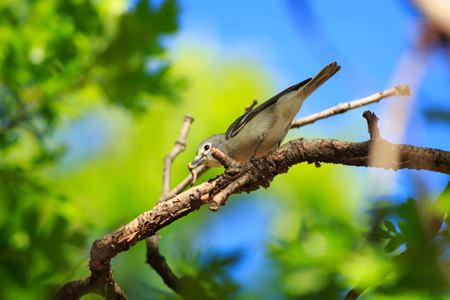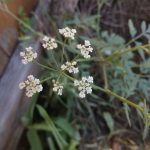These little guys are famished and your trees are a bountiful buffet. But before you banish them, remember this: Song birds are nesting now and caterpillars are the food supply for their young.
Spring is here and so are the caterpillars. These little guys are famished and to their hungry eyes your trees are a bountiful buffet.
But before you go about banishing them, console yourself with this knowledge: Song birds are nesting right now and many depend on these caterpillars as a food supply for their young.

A spring with many caterpillars is a great year for the birds! The seemingly endless supply of fat, juicy caterpillars ensures strong and healthy fledglings. On top of that, young birds right after they fledge have a very high mortality. Caterpillars are an easy food source and give them a greater chance of survival.
Now, allow me to introduce you to the three kinds of wolfish wormlike larva feasting on your trees. The small, green ones with black heads are officially known as oak leaf rollers (Archips semiferana). Spring inchworms are also called spring cankerworms or spring loopers (Paleacrita vernata). The dark ones with dots and two blue stripes on their backs are forest tent caterpillars (Malacosoma disstria) (no, they don’t make tents). All three have only one generation per year and will be gone by early summer.
These caterpillars have quite the appetite and can consume all the leaves from an entire tree. While this is rarely fatal, it does cause a certain amount of stress. A defoliated tree will use up its reserve food supply growing a second set of leaves.
All insects go through cycles but these caterpillars seem especially cyclical. They follow annual paths throughout the Hill Country and South Texas that are known only to them but are likely due to moisture patterns and predator levels.
They all have similar lifecycles in that they all hatch from eggs that are laid on twigs by female moths. But the oak leaf roller and forest tent caterpillar moths lay their eggs in late May, where they spend the summer and winter. The cankerworm spends the summer and winter as a pupa or cocoon before hatching in late February as an adult moth. Adult female cankerworm moths are wingless and they crawl up the trunk of the tree, mate and lay eggs. All three caterpillar species emerge in late March to begin the feasting.
When you see a caterpillar floating in the air, it’s probably mature and finished eating leaves. They produce a silken thread to lower themselves from the tree canopy to the ground where they pupate and hatch into a small, non-descript moth either in a few weeks or the following spring. The severity of next spring’s outbreak will depend on predation and climate conditions between now and then. It’s not necessary to protect your trees from any of these caterpillars. Some years there are many and some years there are very few. Wide population swings are natural and inevitable. If anything, a good soaking when needed and a two-inch layer of compost and mulch mixture are the most important treatments.
Of course, pesticides are generally not recommended because the song birds are doing their part to control the caterpillar population.




